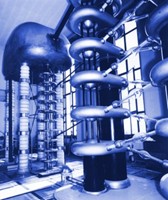 |
 |
| A virtual coffeehouse for
technological minds and ideas |
||
|
INFN researcher invents a new technique for particle accelerators
Content: Press Release Date Issued: 5 June 2008
In fact, thanks to the technique developed by Raimondi, it should be possible a ten-fold increase of the efficiency of the accelerators, greatly reducing the energy they require. In other words, it is possible to "dope" the existing accelerators and create new ones that are much more powerful and capable of providing answers to the great mysteries of the nature of all things, mysteries that scientists have been unable to solve. In the existing accelerators (for example, the Large Hadron Accelerator - LHC, the giant machine that will be inaugurated in October at the CERN laboratories in Geneva], the number of particles that can be stored in the bunches that collide (which allows the Universe's structures to be studied) has already reached a maximum; thus only a certain number of collisions can be performed in a certain time and on a certain surface. Raimondi has taken a previously known technique and has adapted it to the accelerators, where the particles collide. To do so, he modified the DAPHNE collider in Frascati - where he directs the Accelerators Division. In only two years time he progressed from the technique's conception to its concrete realization: with the same energy as before, the DAPHNE collider can now see many more collisions, that is, more events. The collider has increased what physicists refer to as its "luminosity". "We had to modify 50 percent of the accelerator" - explains Raimondi - "We saw the advantages of the new system right away: the luminosity increased immediately by 50%, and this is only the beginning. Of course now the new configuration of DAPHNE is that of a compact car that goes as fast as a Ferrari. DAPHNE has the third highest absolute luminosity in the world, yet its energy is much lower than that of the other machines; thus it has an extremely high ratio of luminosity to energy". "Worldwide there has been a great amount of attention and anticipation regarding the results that we've been producing in Frascati" - explains the INFN's President Professor Roberto Petronzio - "The first tests have indicated that we're on the right track. Now we're thinking of also developing a machine to study the virtual presence of the heavy particles that the LHC could produce at low energies. This is a fundamental scientific task; this research is complementary to that which will be done using the LHC in Geneva. We want to construct a "b factory", a machine that produces enormous quantities of quark b, and now we can make one that will have a luminosity that is 100 times greater than the only two that currently exist, the one at SLAC in California (which has just finished its research) and that of KEK in Japan". Moreover, for Petronzio, using "the b factory may be the trigger for developing the new free electron laser that we want to construct at Frascati and Tor Vergata in southern Rome, which could become the world's most powerful laser, together with that of DESY in Germany. It would be a supermicroscope capable of providing a fundamental contribution to research in Molecular Biology, Genetics, and Medicine". Contacts Infn - Pantaleo Raimondi Mob. +393299412828 Email: pantaleo.raimondi@lnf.infn.it |
add to favorites
|
 del.icio.us
del.icio.us
 Slashdot It!
Slashdot It!
 Stumble It!
Stumble It!
Home | About Us | Advertise | Submit an Article | Submit a Link | Contact Us
ElectronCafé.com is a registered property of electricalfun.com Copyright © 2008 - All rights reserved
